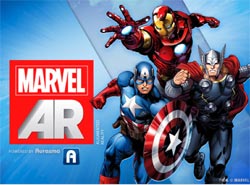Commentary
Excelsior! Augmented: Marvel's AR Comics Show Promise Of Enhanced Print
- by Steve Smith , Staff Writer @popeyesm, April 11, 2012
 While so many eyes have been on magazine and newspaper media and their desperate embrace of mobile technology, one of the most interesting sectors of old
media on new platforms is the comics.
While so many eyes have been on magazine and newspaper media and their desperate embrace of mobile technology, one of the most interesting sectors of old
media on new platforms is the comics.
Long before Apple instituted its newsstand, for instance, DC, Marvel, Image, Dark Horse and others like powerhouse distributor Comixology were demonstrating how mobile or tablet apps could make a superb periodical merchandising machine and reader/library.
These publishers and their apps have been way ahead of the curve in playing with different pricing and sales models, day-long price breaks and bundling. And digital comics is one medium that in many ways offers a richer aesthetic experience than print. The new HD versions of some of their wares for the iPad with Retina Display are just breathtaking.
But like most of print, comics too are trying to stem the flow of eyeballs away from dead tree and ink by tying analog to digital formats. Marvel’s “AR” experiment launched this month with select comics that bear a Marvel AR logo. Users can download a smartphone app and point the camera view at the cover or certain pages to get an overlay of content.
Clearly still in early test mode, I give Marvel credit for experimenting with several kinds of enhancements. Rather than take cues from the early AR conventions of popping up a 3D model from the page, they amplify rather than dazzle. The cover of the AvX (Avengers vs. XMen) issue I tried pans and scans the cover in the smartphone view and animates a thunder background. We get an animated story intro. On the credits page there is the (perhaps obligatory) animation of one of the series creators explaining the AR effects. But after that, we get genuine value-adds. In several cases the AR view superimposes on the comic art a walkthrough of the original sketches and inks, demonstrating the evolution of the page. In another we see a (too small) profile of one of the characters pop up. And in another we get a voiceover from one of the artists explaining the scene.
There are only a smattering of these AR additions throughout the experience, so in some sense it feels gratuitous rather than fully programmed. But as an experiment in AR-enhanced print it succeeds by not trying too hard. The enhancements are editorially sensible and feel like decent DVD extras. As a very big fan of the tablet as a comics viewer, I am looking forward to having these same sets of AR enhancements embedded into the digital comics experience.
To see an amazing and exhaustive example of how this might work, check out Art Spiegelman’s MetaMaus. This book about the making of the Pulitzer Prize-winning graphic novel about the Holocaust has a digital and super-enhanced digital version of the original books on DVD. Virtually every frame of the comic can be clicked through to many versions and preliminary sketches. Spiegel has contextualized voiceovers, along with tapes of his father recalling the horrors of the camps. This is the kind of staggering depth and layering of information that digital tech makes possible and mobile platforms can put in our hands to use on any other medium.
As it starts to settle down from its days of gee-whiz 3D razzle and dazzle, AR will become more powerful as its content becomes more editorially driven and aimed at genuinely “augmenting” rather than reconfiguring the real world.



